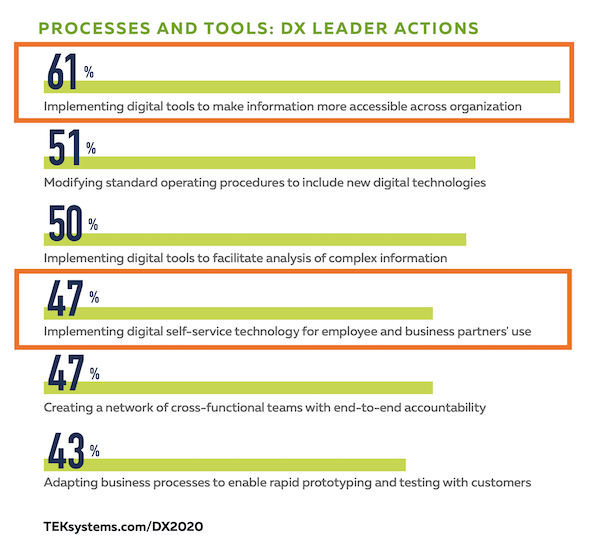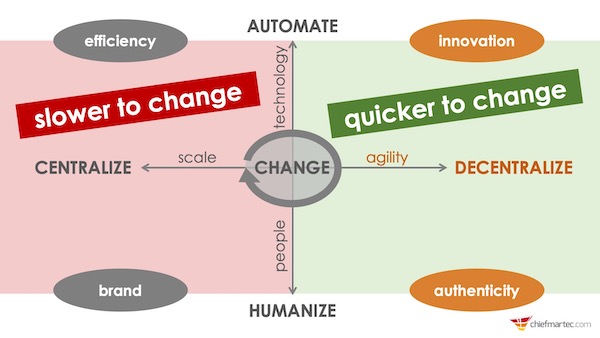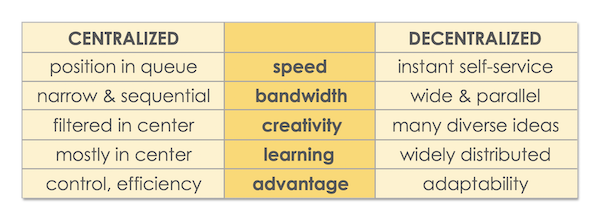TEKsystems, who provides a lot of digital transformation services to Fortune 500 companies, recently released their 2020 State of Digital Transformation report. Since I’ve been cutting back on my all-night disco dancing at the clubs lately, I had some extra time to read through it last night. They revealed — or confirmed — some key notions of what transformation is all about.
One set of findings was particularly interesting to me — shown in the chart above — were the actions that digital transformation leaders (in contrast to laggards in their survey sample) take with processes and tools.
The two I’ve highlighted:
- 61% implement digital tools to make information more accessible across the organization
- 47% implement digital self-service technology for employees and business partners
Regular readers will recognize these as part of theme that I’ve been fascinated by for the past couple of years: balancing centralization and decentralization in marketing operations. This is a concept that Gartner recently confirmed is gaining momentum in their most recent marketing organizational research.
This culminated in my article on Platforming Marketing: 8 P’s of Self-Service Martech.
So it’s incredibly encouraging to see the data from TEKsystems that confirms empowering the decentralized organization — staff and partners on the edges, not just at the center of the firm — is one of the markers of digital transformation success.
(I’d also note that the last two — cross-functional teams and adapting business processes to enable rapid prototyping and testing with customers — support another one of my favorite themes: agile marketing. If you read the latest data on agile marketing adoption side-by-side with the TEKsystems report, you will immediately see the parallels.)
Now, just because I’m an advocate for decentralized marketing capabilities does not mean that I’m against strong centralized leaderships and services. In fact, a strong center can actually better enable a successful decentralized org — it’s not a paradox. Indeed, that is exactly what platforming marketing is all about.
But in reflecting on the current coronavirus crisis and seeing how different organizations are adapting to dramatically unexpected circumstances, I’ve realized that the speed by which the decentralized part of the organization can change is remarkably faster than even a highly agile center.
Don’t get me wrong. The center can change. It will change. And in an agile organization, it can change quite rapidly.
But the very nature of centralized teams and infrastructure is that they have to queue the number of projects they’re dealing with at any one time (“work in progress” limits for you Kanban fans out there). They have to filter for the greatest common denominator. And they have to implement some degree of governance — both technology and policy — in order for the decentralized organization to be harnessable energy instead of total chaos.
Mathematically, the decentralized part of the organization will inherently change faster than the centralized part.
Which brings us back to the current situation. The more decentralized capabilities a company has, the better — and faster — they seem to be adapting to the disruptions and uncertainty of the present day. And that’s to the credit of the centralized leaders who intentionally enabled those capabilities.
Or, as the TEKsystems report confirms: it’s what makes them a digital transformation leader.
P.S. I leave you with this week’s wonderful cartoon on digital transformation and organizational change from the talented Tom Fishburne:






